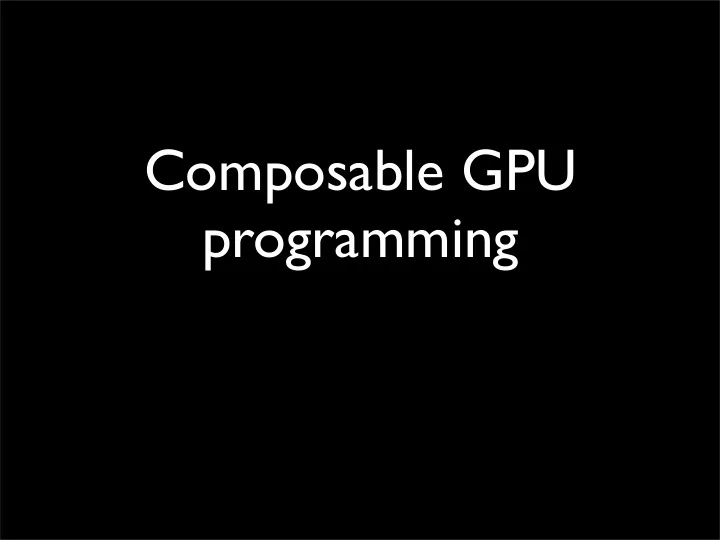

Composable GPU programming
GPUs -- what are they? • Basic model: SIMD, SPMD, MIMD; • blocks of PUs with single PC, local memory (synchronous); warps • many blocks (asynchronous), VRAM • discontinuities/constraints from hardware implementation of memory access; • next-generation hardware likely to mediate this to make programmability more orthogonal
GPUs -- what are they? Revenge of the PRAM? • Basic model: SIMD, SPMD, MIMD; • blocks of PUs with single PC, local memory (synchronous); warps • many blocks (asynchronous), VRAM • discontinuities/constraints from hardware implementation of memory access; • next-generation hardware likely to mediate this to make programmability more orthogonal
Programming GPUs • CUDA: C-like language for general-purpose programming with code generated for GPUs • previously: OpenGL for graphics programming • coming up: OpenCL (compute language) • foo<<m, n, k>> (args) • Execute foo with implicit argument i, j (block, PU) selecting from arguments • Care required when accessing memory: out of sequence accesses sequentialized!
GPU language projects • Data parallel Haskell: • Programming flat PRAM level • Nested/compositional programming • map (map f) (xss) • Obsidian: Combinator language for generating CUDA code • explicit synchronization • choosing threads, mapping to blocks
How to exploit? • Performance: If you have a data parallel problem, formulate it using scan, map, fold, permute on bulk data (arrays), have it shipped out to a GPU! • If you can’t figure out how to do that, do not expect magic from your compiler.
Qualities • Obsidian good candidate for capturing two-level model (synchronous blocks and asynchronous sets of blocks) and implementing APRAM model • Excellent scan implementations • Data parallel Haskell good model for programming APRAM model and for compositional abstraction on top of that • NESL with h.o. functions, polymorphism
Requirements • Need a robust performance model: NESL at PRAM level, sth else lower; • Need to stay in the same programming model when engineering/tuning code • Need a robust programming model (sw/ hw) -- small changes shouldn't lead to unpredicatable radical changes in performance.
(End)
Recommend
More recommend